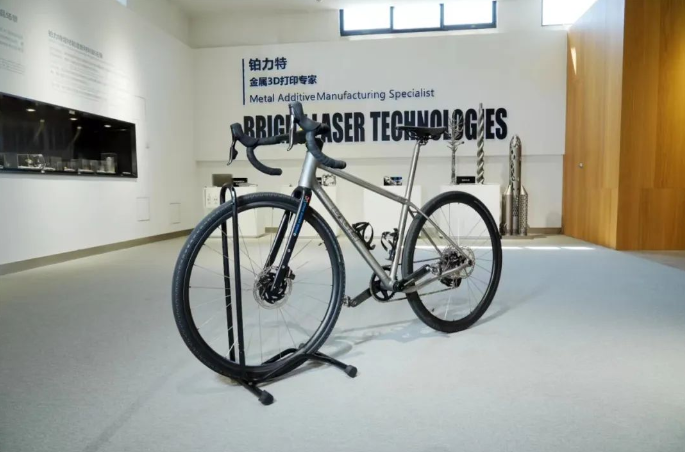Working with Bright Laser Technologies (BLT), bicycle manufacturer Titan Super Bond has developed the first fully 3D printed titanium alloy bicycle frame in China and Asia.
Employed by Titan Super Bond, the BLT-A320 machine helps produce high-precision titanium alloy bicycle handlebars and head tubes known for their lightweight, high strength, corrosion resistance, and long service life. This lightweight design contributes to reduced overall vehicle weight, improving speed, while the high-strength titanium alloy frame facilitates efficient power transfer, enhancing maneuverability, and offers exceptional shock absorption capabilities.

Bicycle manufacturing made easier with metal AM
The decision to adopt metal additive manufacturing addresses challenges faced by the Chinese bicycle industry in developing high-end parts, says the company. With precise control and high-quality machines, metal 3D printing proves instrumental in producing complex structural parts while meeting industry requirements for accuracy (0.03mm). Customization capabilities optimize rider posture and energy output.
Metal 3D printing simplifies and streamlines production compared to traditional processes like precision casting, CNC machining, wire cutting, welding, calibration, and surface treatment. This leads to a 30% cut in production cycles, over 20% savings in materials, increased production efficiency, strengthened welding areas, reduced labor intensity, shorter working hours, and paves the way for future robotic automated welding.
Efforts in bicycle manufacturing using metal 3D printing made headlines in the past. For instance, Sturdy Cycles, a bicycle manufacturer, adopted Headmade Materials‘ Cold Metal Fusion (CMF) technology for producing titanium bike parts. In a prior collaboration, the company worked with RAM3D to 3D print components for its road bikes.
On another front, British Cycling sought Renishaw‘s assistance in 3D printing aluminum and titanium parts for its track bike showcased at the Tokyo 2022 Olympic Games. In alliance with Materialise, Canyon unveiled a 3D printed mountain bike prototype for Bike Magazine Germany’s ‘Ride Green’ campaign, showcasing a sustainable manufacturing approach.
BLT’s metal AM capabilities serve the larger 3D printing sector
In 2022, Titan Super Bond experienced a notable enhancement in its R&D and production capabilities in metal 3D printing, thanks to the integration of BLT’s Laser-Powder Bed Fusion (LPBF) metal 3D printing machines, notably the BLT-A320. Coupled with BLT’s comprehensive support, this integration played a pivotal role in Titan Super Bond’s success, contributing significantly to its standing in the high-end bicycle market.
Effectively addressing challenges tied to deformation control of complex parts and weight reduction, the collaboration tackled a significant hurdle presented by parts with a mere 0.9mm wall thickness. Despite the difficulty, the joint effort yielded a holistic solution spanning production processes, part design, support, and lattice control. This comprehensive approach ensured the successful passage of the ISO 4210 dynamic fatigue strength test for the 3D printed parts, affirming their quality and enduring durability.
Away from bicycle manufacturing, BLT’s metal 3D printing technologies were previously used in the healthcare sector. One such example includes the company’s BLT-A160D metal 3D printer helping develop MicroNeuro, the world’s first flexible robotic system for minimally invasive brain surgery. Created by the Centre of Artificial Intelligence and Robotics at the Hong Kong Institute of Science & Innovation, MicroNeuro integrates various technologies, including multilevel flexible endoscopy, high precision control, augmented reality surgical navigation, and artificial intelligence.
Additionally, Chinese medical firm Wedo Bio-Medical Technology secured market approval in China for its 3D printed spinal implant, WedoCage, utilizing BLT’s BLT-S210 and BLT-S310 metal 3D printing systems. The Hydroxyapatite-Coated Porous Titanium Alloy Interbody Fusion Device received a Class III Medical Device Registration Certificate from the National Medical Products Administration.
What does the future of 3D printing for the next ten years hold?
What engineering challenges will need to be tackled in the additive manufacturing sector in the coming decade?
To stay up to date with the latest 3D printing news, don’t forget to subscribe to the 3D Printing Industry newsletter or follow us on Twitter, or like our page on Facebook.
While you’re here, why not subscribe to our Youtube channel? Featuring discussion, debriefs, video shorts, and webinar replays.
Are you looking for a job in the additive manufacturing industry? Visit 3D Printing Jobs for a selection of roles in the industry.
Featured image shows a fully 3D printed titanium alloy bicycle frame. Photo via BLT.


